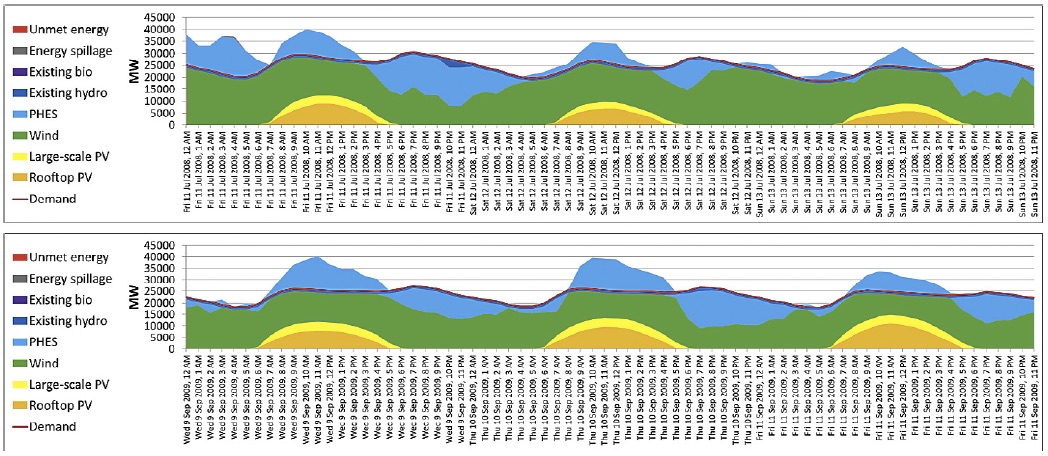A paper by Andrew Blakers, Bin Lu and Matthew Stocks of the Australian National University shows how, and at what cost, the southern and eastern states of Australia could be converted from coal-fired power production, currently two-thirds of the total, to rely solely on renewable electricity. In their calculations power is provided almost entirely by wind and solar, with pumped hydro systems used for storage and new power lines to balance supply and demand. The levelised cost of electricity is calculated to be AU$75 (£44) per MWh, less than current rates.
The paper is an interesting exercise in how a completely renewable electricity supply would work. Previous studies had divided the area into 43 cells and calculated the average hourly wind and solar energy available in each cell between 2006 and 2010. The authors have taken this data and applied various scenarios to match it to the hourly consumption data for the same period. Total demand is assumed constant at the current level of 205TWh per year (UK in 2016: 330TWh). A period of three days using the authors’ baseline scenario is shown below.

Electricity demand for a three-day period in 2008 (red line) and hypothetical supply by renewables. PV energy (in yellow and gold) highlights daylight hours. From Blakers et al.
As might be expected there are times in the day when the demand is less than supply, in which case the excess is used to charge the pumped hydro system (PHES). At other times, mainly at night, power is withdrawn from the PHES. Existing biomass and hydro, which provide about 10 per cent of current demand, are included in the model but are negligible in the period shown. The calculations meet the current Australian standard that unmet demand must be less than 0.002 per cent of the total.
In many ways Australia is ideal for renewable energy. There is plenty of sun and wind, and an enormous unpopulated area over which to capture it. The large area is particularly useful for wind because it allows access to different weather systems: somewhere between Adelaide in South Australia and Cairns in northern Queensland, the wind will be blowing. For this reason (and because it is currently cheaper than solar) wind provides the majority of energy in the baseline scenario above.
Nevertheless the wind capacity needed is 45GW, nearly the same as projected for the UK in 2032, but all onshore. The wind farms would occupy an area of about 100 miles square, which is small in Australian terms, except that the highest winds tend to be near the coast, which is also where the majority of the population tends to be. Some social and environmental objections are likely.
Somewhat surprisingly, from the UK perspective, the majority of the PV power comes from rooftop systems (17GW versus 6GW from utility-scale plants). Australia currently produces 6GW from 1.5 million rooftop systems, but many of these are remote and off the electricity grid. The plan assumes that one quarter of grid-connected houses and commercial buildings will have rooftop PV systems. The big advantage of rooftop systems, from the point of view of the electricity authority, is that they reduce the demand on the grid and are also paid for by the building’s owner.
Also surprising is the use of pumped hydro rather than batteries, because it is cheaper, although the authors recognize that batteries may become important for local storage. They argue that Australia has a large number of possible PHES sites in the hills and mountains of the Great Dividing Range that lie near the main population centres on the eastern and southern coasts. They envisage a storage capacity of 16GW able to provide power at maximum capacity for up to 30 hours.
As discussed in an earlier article (Pumped Storage) PHES has much less environmental impact than a hydroelectric system because it does not block the flow of a river. The land area required for the reservoirs is 12 square miles, all of which could be found outside national parks and environmentally sensitive areas. Calculations of evaporation and rainfall show a small net loss of water, meaning that some water will need to be added from rivers.
The final piece of the puzzle is the transmission. It seems that the present network could not cope with the large amounts of power that must be moved long distances when, for example, there are cloudy windless days in one part of the country. The authors envisage the addition of several high voltage direct current (HVDC) lines each 400 to 900 miles long passing in the flat country inland from the Great Dividing Range, but within 125 miles of three quarters of the population. An undersea connection to Tasmania is included, but not Western Australia and the Northern Territories, which already have their own separate grids.
Adding up all these pieces gives a total cost of AU$184 (£108) billion using today’s PV and wind prices (AU$152 using projected future prices), of which 60 per cent is for PV/wind and 40 per cent for PHES and transmission. Assuming a lifetime of 25 years and a discount rate of 5 per cent per year, the levelised cost works out at AU$93 and AU$75 for current and future PV/wind prices. This compares with the average wholesale cost of AU$80 (£47) in 2017. The cost is most sensitive to the price of windfarms and the discount rate.
The authors have made an admirably complete analysis of how to convert Australia to renewable energy. They have been conservative by using only commercially established technology (no “heroic” assumptions about new developments), but still come out with a competitive levelised cost. Australia may be an ideal place for renewable energy but it is still very interesting to see the possibilities clearly spelt out.





